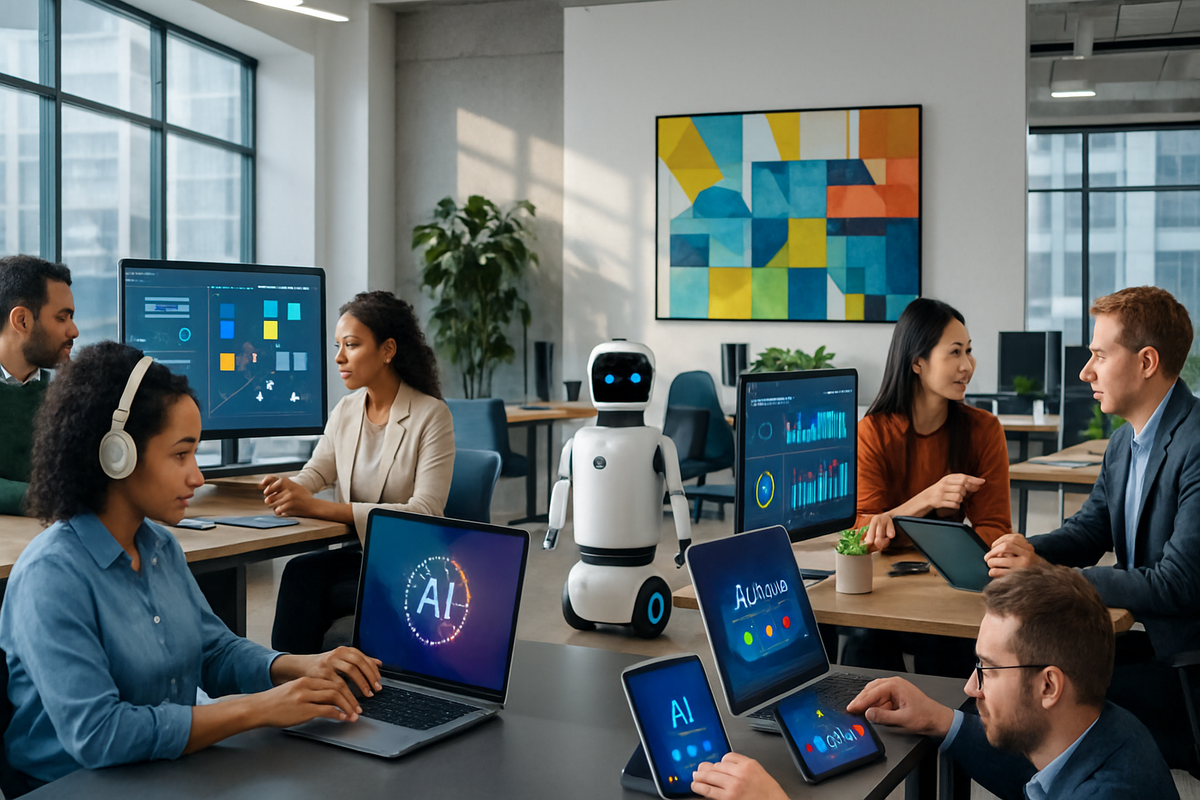Blended Work: How AI Is Quietly Rewriting the Rules of the Global Office
In 2025, the real office revolution isn't remote work—it's AI as your coworker and sometimes your boss. Dive into blended work, where human creativity meets digital intelligence for a new era of productivity and innovation. Are you ready to adapt?

Welcome to the Blended Work Era: When AI Is Your Coworker (and Sometimes Your Boss)
Remember when the biggest workplace drama was whether you could wear jeans on Fridays? Fast forward to 2025, and the real question is: Did you just get feedback from your manager, or was it your AI assistant disguised as a cheery pop-up?
Welcome to the world of blended work—an office where human talent and AI algorithms are not just coexisting, but collaborating, co-writing, and sometimes even co-managing. This isn’t the hybrid work of yesteryear. It's a radical remix, and it’s quietly upending everything from job descriptions to coffee break conversations.
What Exactly Is 'Blended Work'?
Blended work is a step beyond hybrid. It’s not just about where you work (office, home, beach, intergalactic space station) but how you work—with AI tools mediating, enhancing, and sometimes transforming your daily grind. Think of it as the ultimate buddy cop movie: human creativity and digital intelligence, solving problems together (with fewer car chases, but more Slack notifications).
“AI's infiltration into knowledge, creative, and service work is not just about automation—it’s about redistributing agency, creativity, and control.”
— The Future of Work is Blended, Not Hybrid
The Big Picture: Why Blended Work Is the REAL Office Revolution
- AI is everywhere. From automating reports to drafting emails, suggesting project plans, or even mediating team meetings, algorithms have gone from silent assistants to vocal team members.
- Roles are evolving. The most valuable employees aren’t just tech-savvy—they’re “AI-fluent,” able to collaborate with machines and leverage digital insights to make smarter decisions.
- Productivity is being redefined. Forget measuring hours at a desk. In a blended workplace, output, creativity, and adaptability matter more than ever.
Blended Work in Action: Real-World Case Studies
1. The Financial Firm That Let AI Run the Morning Meeting
A London-based investment company recently handed over its daily stand-up to an AI moderator. The result? Meetings ran on time, action items were auto-documented, and introverts rejoiced as the bot diplomatically managed interruptions. Human managers, meanwhile, focused on strategic decisions instead of timekeeping.
2. Marketing Teams Co-Writing Campaigns with AI
Forget creative block. At a global ad agency, AI tools now suggest headlines, analyze past campaign data, and even A/B test messaging in real time. Human copywriters use these suggestions as springboards, blending intuition with data-driven creativity.
3. HR Departments Using AI to Spot Burnout—Before It Happens
By analyzing work patterns, chat sentiment, and break schedules, AI platforms can flag early signs of disengagement or stress. HR can intervene supportively, offering resources or flexible schedules—sometimes before employees even realize they need help.
How to Thrive in the AI-Blended Office: Practical Tips for Every Professional
- Get AI-literate. Learn how to use your company’s AI tools—not just the basics, but the shortcuts, best practices, and ethical guidelines.
- Double down on human skills. Empathy, creativity, negotiation, and critical thinking are now superpowers—because AI can’t (yet) master the art of reading the room or dreaming up the next viral meme.
- Embrace transparency. Understand when you’re interacting with an algorithm versus a human, and demand clarity about how AI-derived decisions are made.
- Protect your boundaries. With always-on AI, work can bleed into personal time. Set clear limits and communicate them—your future self will thank you.
For Leaders: Future-Proofing Your Team (and Your Sanity)
- Invest in continuous learning. Encourage your workforce to upskill with AI and digital literacy courses. Udemy and LinkedIn Learning are goldmines for this.
- Foster a culture of experimentation. Let employees test new AI tools, share feedback, and co-create guidelines. The best ideas often come from the bottom up.
- Prioritize well-being and flexibility. Blended work isn’t just about efficiency—it’s about making work work for people. Listen to your team, iterate policies, and remember: a happy human is still your best asset.
Your Blended Work Starter Kit: Must-Have Tools & Tech for 2026
- Collaboration: Microsoft 365, Google Workspace, Notion, Monday.com
- Communication: Zoom, Slack, Teams, AI-powered meeting assistants
- Productivity & Automation: Zapier, Otter.ai, Grammarly, custom AI bots
- Security: NordVPN Teams, enterprise-grade cybersecurity suites
- Learning & Development: Udemy for Business, LinkedIn Learning, Coursera
Bonus tip: Don’t sleep on AI-powered ergonomic office gear. Your back (and your chiropractor) will thank you.
Final Thoughts: The Human Edge in a Blended World
The future isn’t man vs machine—it’s humans plus machines, combining our quirks and questions with the relentless logic of algorithms. The winners? Those who can blend both, not just survive but thrive in this new office ecosystem.
“The question is not whether we accept it, but whether we actively shape it before it shapes us.”
— The Future of Work is Blended, Not Hybrid
Want to stay ahead of the curve in the age of AI-blended work?
Subscribe for free to Funaix Insider and join a smart, curious community. Only subscribers can read and write comments on our blog—and for now, it’s absolutely free. Don’t miss your chance to help shape the future of work, one insightful discussion at a time!




